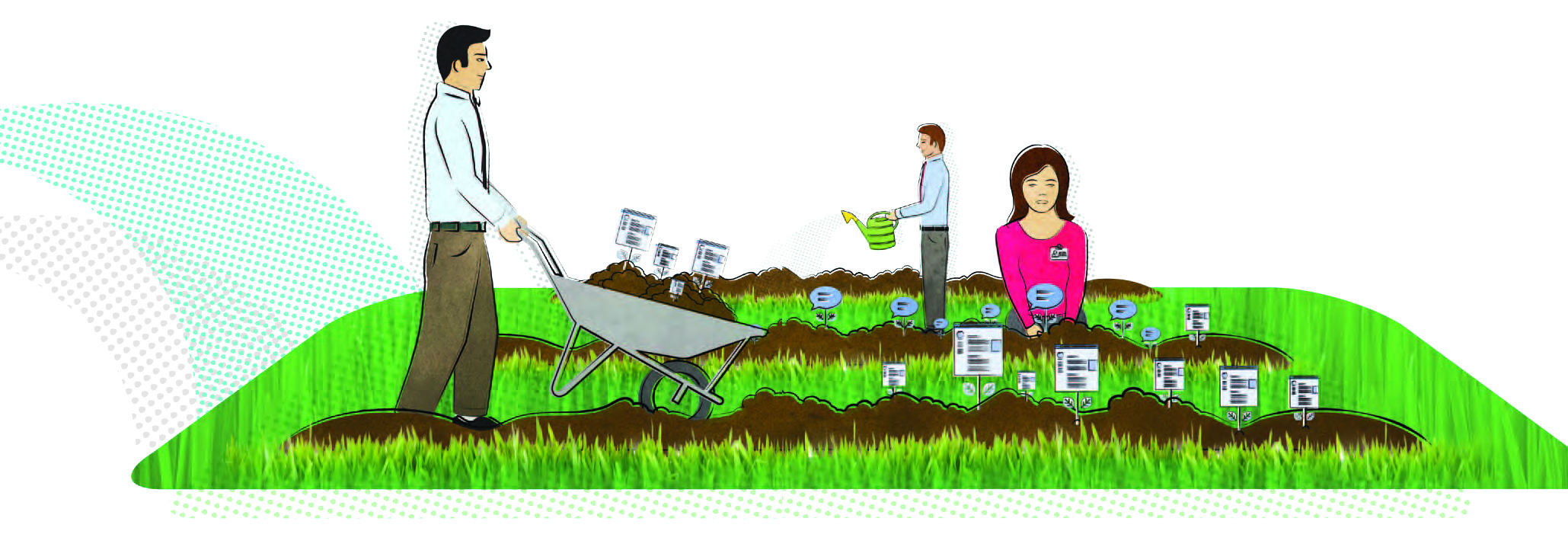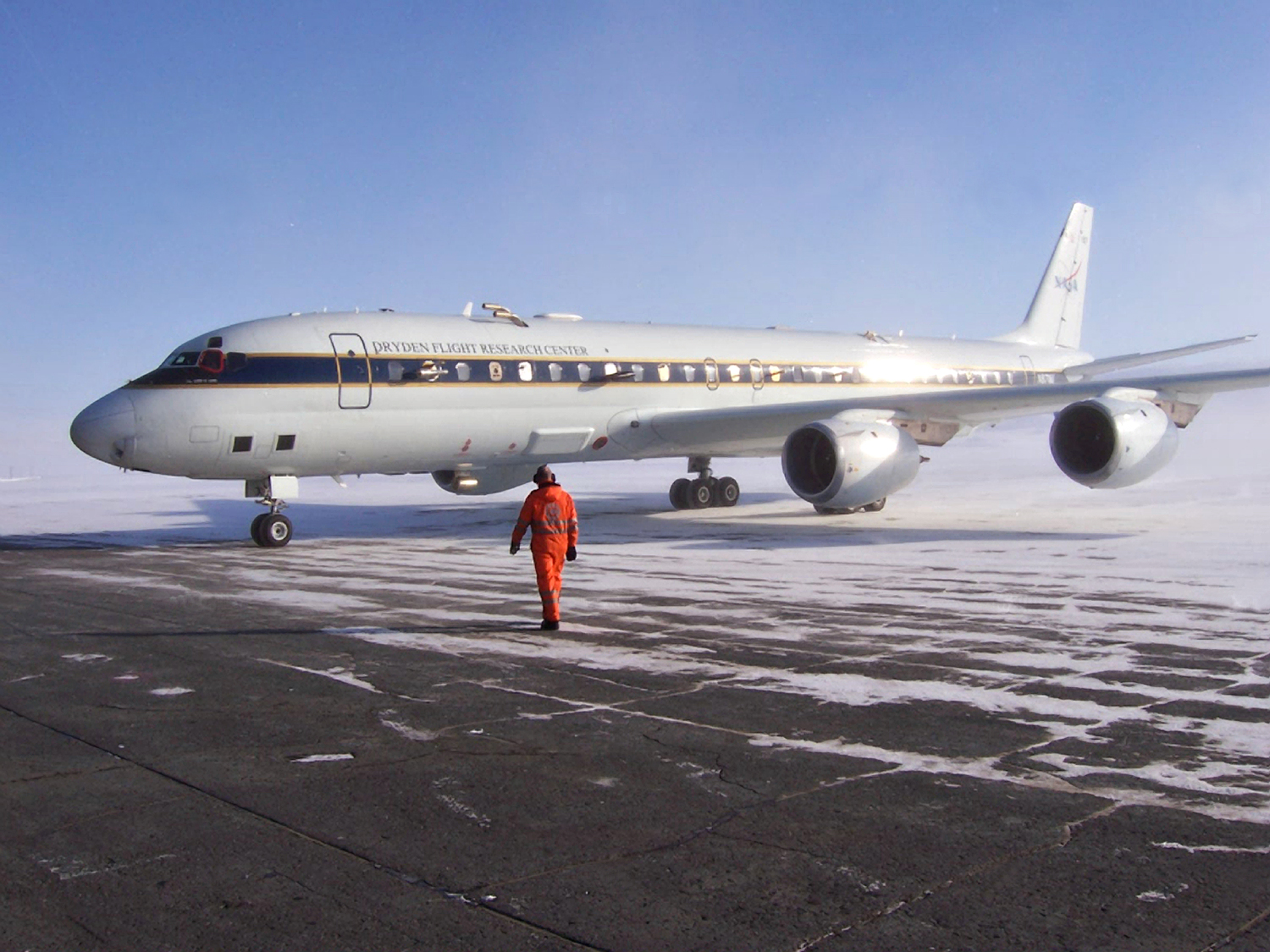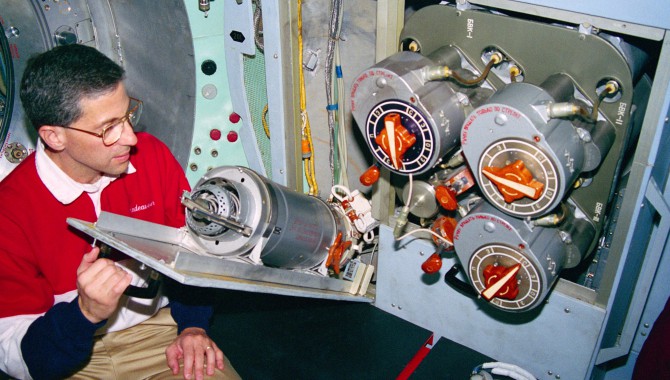
Supplying oxygen is only one of many life-support necessities for human spaceflight, but it’s obviously one of the most vital.
The main oxygen-generation system aboard the International Space Station has a backup system to ensure breathable air is always available. It is known by various names: the solid-fuel oxygen generator or SFOG; Vika; and TGK, an acronym for the Russian name of the system. In September 1999, one year before Expedition 1 was to launch the first crew to station for an extended duration, the TGK was undergoing urgent testing in Moscow because of a life-threatening accident.
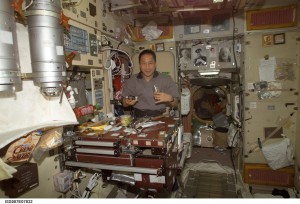
Astronaut Edward T. Lu, Expedition 7 NASA ISS science officer and flight engineer, eats a meal in the Zvezda service module on the station. The TGK system can be seen in the upper left without the ceramic mitigation screen in place.
Photo Credit: NASA
Originally designed by the Russian Federal Space Agency, Roscosmos, the TGK provided additional oxygen for the Mir space station when more than three people were on board. It created oxygen by igniting a solid, oxygen-rich compound within a canister, commonly referred to as a “candle.” About the size of a fat spray can, one candle contains nearly a liter of lithium perchlorate and, when burned, could provide enough oxygen for one crewmember for one day. The same system exists on civilian aircraft, using smaller candles per row to provide oxygen if those yellow masks pop out from the overhead compartment.
Since the TGK had been tested and proven, first by the Russian space agency and then by NASA when plans for the International Space Station (ISS) assembly were being drawn up, the newly formed international team agreed it was the best supplemental-oxygen system available. During the assembly process, most of the TGK system—renamed the SFOG within NASA—launched to the ISS.
In February 1997, a TGK candle aboard Mir malfunctioned and burst into flame. The metal tube that contained the reactive, oxygen-producing chemicals inside the candle began to burn in the increased oxygen concentration, launching globules of molten, flaming metal into zero gravity that splattered onto the opposite bulkhead. The fire was a “raging blowtorch,” according to American astronaut Jerry Linenger, who was on board during the accident. “I’ve never seen smoke spread like it did on Mir,” he said. Crewmembers used three fire extinguishers to put out the fire, adding clouds of steam to the smoke filling the cabin. Russian cosmonaut Aleksandr Lazutkin recalled the accident in a BBC documentary: “When I saw the ship was full of smoke, my natural reaction was to want to open a window. And then I was truly afraid for the first time. You can’t escape the smoke. You can’t just open a window to ventilate the room.”
Those involved in the still-developing ISS immediately shared the fear of the system having a similar accident aboard station, and both NASA and Roscosmos began their own investigations. Since all evidence of what had caused the mishap had burned during the incident, those on the ground had no definitive proof of what had gone wrong.
Meeting in Moscow
In the two years following the accident, after testing other options and designing their own alternative, NASA determined the TGK was still the best option available for the backup oxygen system. During that time, Russia worked to improve the safety of the candles and to develop a fire-resistant screen to help mitigate a fire in case another candle malfunctioned. To learn more about their improvements and mitigation efforts, NASA sent a team to Moscow.
David Urban, a microgravity scientist from Glenn Research Center, and Harold Beeson, an expert on materials flammability in high-oxygen conditions from White Sands Test Facility, arrived as part of that team in August 1999. Frank Buzzard, who was then the ISS chief engineer, paved the way for the new collaboration to go as smoothly as possible.
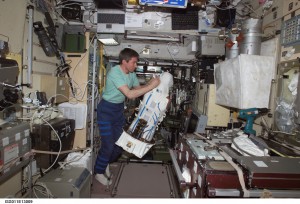
Cosmonaut Sergei K. Krikalev works with the European Space Agency Matroshka radiation experiment in the Zvezda service module of the International Space Station. In the upper right of the foreground is the TGK backup oxygen system, with the ceramic mitigation screen in place.
Photo Credit: NASA
“The culture there is very different than NASA,” said Urban, “things that are beyond the language. In a NASA meeting, you would have a printed copy of PowerPoint slides in front of you. In Moscow, a question would be asked, and one piece of paper would come out of a folder to circulate around the table and then go back.”
There was also a delicate political balance to maintain.
“You didn’t want to be the ugly American that’s standing back and saying, ‘You had a failed system,’” Beeson explained. “We wanted to make sure that we could build the team that was trying to solve this problem, with everybody’s focus on the problem and not on assigning blame.”
“We had to convince them that we were there to work with them and not there to shoot the system down,” added Urban. Part of showing their support for all the work the Russians had done was to refer to the system by its original Russian acronym, TGK, instead of the NASA acronym, SFOG.
The team needed to collaborate well, and quickly. The remainder of the TGK system and additional candles were already on board the first Progress spacecraft to supply the ISS.
In an attempt to foster good relationships at the outset, the NASA contingent would invite their Russian teammates to lunch each day. “It took us a week to get them to let us eat with them,” recalled Urban. The first day the NASA team arrived, the Russians said they should plan for lunch and recommended a restaurant. “We all loaded up into the van when lunchtime came and pulled up outside the restaurant. We get out, and none of them come in. Fortunately, astronaut Sandy Magnus was there, who spoke more Russian than the rest of us, so she helped us interpret.”
Urban and Beeson quickly learned that the restaurant was not affordable for their Russian teammates, but the Russians were unwilling to take their NASA colleagues to their cafeteria. A few days later, they visited a remote testing site. “The guy who ran the site had been to NASA in Cleveland, so he was more comfortable with us, and we went to the cafeteria,” said Urban.

After igniting a contaminated candle, a fire begins and progresses (from left to right) to a flame jet, then slows down until the fire stops.
Photo Credit: NASA
“That was great.”
“When we actually went to their cafeteria and were able to eat with them, sit down with them, that helped,” added Beeson. “A meal is always a good thing to share.”
The working relationship among the team swiftly improved after that. Urban explained, “We’d built a familiarity, they were relaxing, we had spent some time together and communicated during meetings.”
The plan that then developed included the Russian team preparing four TGK cassettes designed to ignite while NASA’s White Sands Test Facility would make several copies of a TGK simulator that could be burned up in testing. The Russians would provide a test facility, the protective screen, and support staff to operate the experiments. White Sands had to create a simulator that captured the major features of the TGK and would interface with the Russian system. Paralleling these decisions were discussions about providing support analysis of the heat and product released from an event of this type. This would allow them to more easily share the results of their respective testing.
“Everybody came to understand that this event was something that could happen again,” said Beeson. Because most of the TGK was already in space and limited funds prevented Russia from building an on-the-ground fixture for testing, NASA would build the test system and Russia would provide the candles and fire-mitigation screen they had developed. In one month, they would bring the pieces together to see how the modified TGK performed.
Testing with Limited Time
NASA’s team had a little over one month to design, build, test, and ship a TGK test unit to Moscow. Since the original TGK evidence had burned up on Mir, NASA’s microgravity and combustion experts had to first recreate the accident as best they could. This would allow them to verify if the protective screen the Russians designed for the system would successfully mitigate a fire.
Russia’s extensive testing after the Mir fire resulted in several theories about the cause of the accident, but the definitive cause could never be known since the fire destroyed the evidence. “They found two techniques that would do it, and one of them they thought was more plausible than the other,” explained Urban. “Either they had a small piece of material in the ignition system that was mismixed so it had more energy-producing material that would cause the reaction to run away, or they had a small amount of contamination inside the canister—such as a four-square-centimeter piece of rubber glove folded in between the interior and side wall. There were people wearing rubber gloves when making the canisters, so they believed that was the obvious cause.” Using these theories provided a basis for the joint NASA–Roscosmos testing.
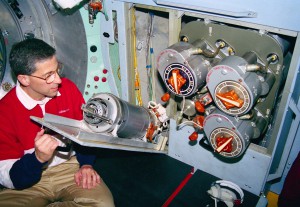
Astronaut Jay Apt looking at a solid-fuel oxygen generator like the one that caught fire on Mir.
Photo Credit: NASA
Once the test fixture was completed, NASA shipped it to Moscow in a 4 x 4 x 6–foot crate. “The TGK itself is not a huge unit,” Beeson explained, “but we had to design and put together the test stand and holders for the canisters. We had to include a way to interface our ignition system with their canisters, and also ship all our tools and instrumentation. We needed to measure thermal levels so we could understand if their mitigation screen was getting too hot. We shipped everything, including our welding goggles, because this is molten metal burning, and you don’t want to be viewing that with your naked eye.”
The NASA team reunited with their Russian teammates in Moscow in mid-September, where all the pieces would finally come together for joint testing. Astronauts and cosmonauts who had experience with the TGK provided their insight as well. This included astronaut Sandy Magnus, who was assigned as a “Russian Crusader” in 1998 and had been traveling to Russia to support hardware testing and products development, and cosmonaut Aleksandr Lazutkin, who had witnessed the 1997 Mir fire. “He came in for a short period of time to view the videos of fires we had created at White Sands, and he was able to say, ‘That’s what that fire looked like in Mir,’” said Beeson. This helped confirm that they were creating a fire large enough and hot enough to stress the system and mitigation screen.
The screen itself was made of ceramic and provided a housing, much like a fireplace, to control any fire that might occur and contain molten metal that could fly off a burning canister. It covered the back, sides, and bottom of the system and included a front screen to prevent spatter but allow oxygen to filter through for the igniting spark required for the candle. The screen withstood the joint testing in Moscow, but the team discovered an issue with operating procedures the Russians had provided for the screen.
“The original operations concept required the astronauts to have the fireplace screen at the ready, but they wouldn’t necessarily attach it unless they had a fire event,” said Beeson. “We questioned that. And once we lit off the first canister, it became clear to the Russians that it was not going to be an appropriate operations concept. They saw just how much molten, burning metal was coming off the canister.” As a result, the operations concept changed. Once the astronaut placed the candle in the TGK, he or she would install the screen before igniting the canister.
A little over one year later, in October 2000, Expedition 1 launched with the first crew to take up residence aboard ISS. And while the TGK system has changed a little over the years, it has not experienced a fire since its installation on the station.
A Memorable Beginning
The ISS did not have a smooth start. When the program was announced, Russia was still recovering from the social and political turmoil of perestroika, the United States did not have long-duration human spaceflight experience, and both countries were figuring out how to work together after the end of the Cold War. But amid such chaos, individuals from NASA and the Russian Federal Space Agency were able to create cohesive teams. Ensuring the TGK was safer and ready to sustain life aboard the biggest, newest internationally collaborative effort was just one of many instances of this teamwork.
“There’s things in your career that you really remember,” said Beeson. “This is one of those. I really felt like I had a direct contribution to the astronauts’ safety, which is so important to us. And understanding this failure and successfully working with our international partners to mitigate it was a memorable event. We worked with a great team.”
More Articles by Kerry Ellis
- Permission to Stare-and Learn (ASK 42)
- X-15: Pushing the Envelope (ASK 40)
- Engineers Without Borders (ASK 39)
- NextGen: Preparing for More Crowded Skies (ASK 38)
- Science from the Sky (ASK 36)






